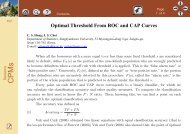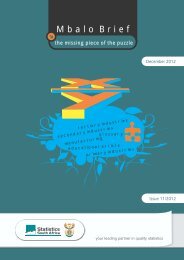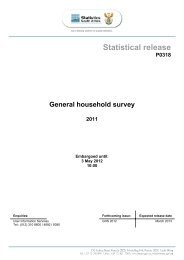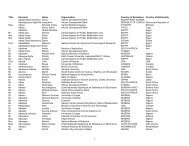Post-enumeration Survey (PES) - Statistics South Africa
Post-enumeration Survey (PES) - Statistics South Africa
Post-enumeration Survey (PES) - Statistics South Africa
Create successful ePaper yourself
Turn your PDF publications into a flip-book with our unique Google optimized e-Paper software.
<strong>Statistics</strong> <strong>South</strong> <strong>Africa</strong><br />
27<br />
There was no non-response adjustment at EA level or household level for <strong>PES</strong> 2011. Hence the<br />
inverse selection probabilities were applied as calculated from the 'PROC SURVEYSELECT'<br />
without any further adjustments.<br />
5.2 Coverage evaluation: Calculation of dual-system estimates for persons<br />
Coverage measures were calculated only for cases belonging to the universe of interest (Section 2.2:<br />
Scope of the <strong>PES</strong>).<br />
1. The initial estimates – weighted estimates of total from the sample – using Procedure C, are (also<br />
see Figures 1 and 2):<br />
a. total number of non-movers in the universe (P sample);<br />
b. total number of out-movers in the universe (P sample);<br />
c. total number of in-movers in the universe (P sample);<br />
d. total number of matched non-movers in the universe (P sample);<br />
e. total number of matched out-movers in the universe (P sample);<br />
f. estimated total number of matched in-movers in the universe;<br />
Note: in Procedure C, the number of matched in-movers cannot be calculated directly, given that<br />
matching the in-movers in the sample is not attempted. But the 'out-movers' and the 'in-movers'<br />
constitute the same group in the universe: the 'movers', assuming a closed population. Therefore,<br />
an assumption can be made that, in the universe, the match rate for in-movers would be the<br />
same as that for out-movers (estimated by e/b). Hence, the total number of matched in-movers in<br />
the universe is estimated indirectly by [(e/b)*c].<br />
g. total number of census erroneous inclusions in the population (E sample);<br />
h. total number of cases correctly enumerated in the census but missed in the <strong>PES</strong> (E sample);<br />
i. total number and percentage of census persons with insufficient information (E sample); and<br />
j. total number and percentage of <strong>PES</strong> erroneous inclusions and <strong>PES</strong> insufficient information cases<br />
(P sample).<br />
<strong>Post</strong> Enumeration <strong>Survey</strong> (<strong>PES</strong>)















